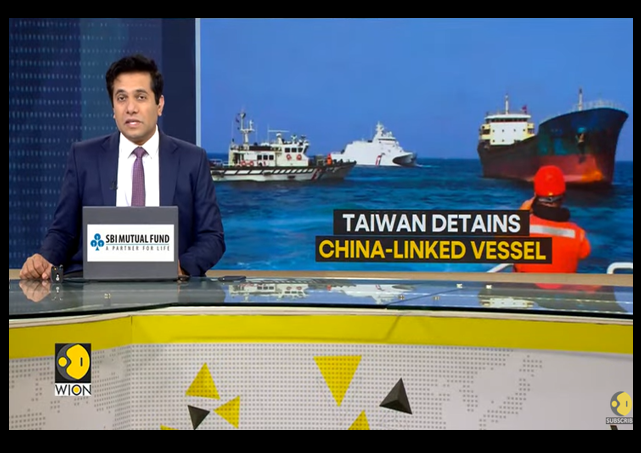Taiwan Detains China-Linked Ship Suspected of Cutting Undersea Cable
“It cannot be ruled out that it was a grey zone intrusion by China.”

The Chinese appear to be back at their undersea cable-cutting antics again.
Legal Insurrection readers may recall our report on the possible sabotage of critical communication cables in the Baltic Sea.
At the end of 2024, Sweden requested help investigating the Yi Peng 3, a Chinese-flagged bulk carrier suspected of being involved in the incident. The ship may have dragged its anchor over cables connecting Sweden to Lithuania and Finland to Germany.
Subsequently, after the clipping of several more undersea cables, NATO began increasing Baltic Sea patrols.
The move may explain why China took its cable-slicing crews to other waters.
Taiwan’s coast guard (CGA) detained the Chinese crew of a Togolese-registered vessel suspected of severing an undersea fiber optic cable connecting the islands of Taiwan and Penghu on Tuesday.
The CGA says the vessel, the Hong Tai 168, had been loitering within roughly 925 meters of the cable since 7 p.m. local time on Feb. 22. A coast guard vessel was dispatched to the ship at 2:30 a.m. on Tuesday, demanding that the vessel leave the area, Taiwan’s state-owned media said.
Coast guard officials received confirmation that the Taiwan-Penghu No. 3 undersea cable had been cut at 3 a.m. Tuesday, and they began efforts to detain the ship’s Chinese crew. All eight crewmembers were Chinese nationals, according to the coast guard.
BREAKING:
The Taiwanese coast guard is boarding the Chinese-owned vessel ”Hong Tai” after it was caught destroying an undersea telecommunications cable between Taiwan & its Kinmen island near China.
The crew, which is all Chinese, is being detained and taken to Taiwan.
— Visegrád 24 (@visegrad24) February 25, 2025
Taiwanese officials are investigating whether the damage was intentional or accidental. The incident is considered a potential “gray zone operation,” a term used for coercive actions that do not escalate to outright warfare.
…Taiwan fears China could sever its communication links as part of an attempt to seize the island or blockade it.
“It cannot be ruled out that it was a grey zone intrusion by China,” the coast guard said, referring to actions that fall short of an act of war.
“The coast guard will cooperate with the prosecutors in the investigation and make every effort to clarify the truth.”
Members of the crew were still being questioned by prosecutors on Tuesday evening, a coast guard official told AFP.
BREAKING:
An undersea telecommunications cable between Taiwan & its Kinmen island near China has been destroyed.
Taiwan’s coast guard detained the crew of the China-owned vessel “Hong Tai” after the "Taiwan-Penghu No. 3 cable” was destroyed this morning
The crew is all Chinese pic.twitter.com/FngiokjlgL
— Visegrád 24 (@visegrad24) February 25, 2025
Fortunately, communications to the impacted area were quickly rerouted. However, it turns out this is the latest in a series of cable-damaging incidents in that region.
The cable that was broken is one of several connecting the Penghu Islands, also called Pescadores, to the main island. Communications were quickly rerouted after the damage was detected, and there was no major outage, the authorities said.
Taiwan usually depends on undersea cables for its internet connections with outlying islands, such as the Penghu Islands, as well as for its connections to the rest of the world. Cables can be severed by natural factors like earthquakes or aging, but the most common cause is when ships drag anchors or fishing equipment that scrapes the sea floor.
Recent incidents off Taiwan and in the Baltic Sea have raised suspicions among some officials and experts that China and Russia may sometimes deploy commercial cargo ships or oil tankers to deliberately cut cables by dragging their anchors.
Two years ago, a cable between Taiwan and Matsu Island was severed. Earlier this year, a digital cable connecting Taiwan with South Korea, Japan, China and the United States was damaged, and Taiwanese authorities said that a Chinese ship may have dragged its anchor across the cable, either accidentally or deliberately.
The targeting of these cables has the potential for significant economic impact.
According to NATO chief Mark Rutte, more than 95% of internet traffic globally is carried via undersea cables, with some 1.3 million kilometers of such cabling securing an estimated $10 trillion dollars of international trade daily.
 DONATE
DONATE
Donations tax deductible
to the full extent allowed by law.











Comments
And they’re charging the crew with piracy, right?
“Gray zone”, hell. China is actively engaged in biological, technological and economic warfare against the rest of the world.
Every now and then, I bring up the old “kow-tow” incident when discussing China. It’s not so much for the “brave, bold English ambassador” bit, but for the understanding that China has always viewed itself as properly ruling the entire world – just some of them don’t know it yet. I think that’s a concept that hasn’t changed from the emperors to the CCP.
It is. To me, it’s interesting over the last 30-years, several of the countries that adopted tepid or even hostile positions towards US’ ‘Imperialism’ – like Argentina and the Philippines – are now seeing actual Imperialism being waged against them by the Chicoms.
Looking at the map, it seems easier to simply shut down communications at the China end rather than damaging the cable. Shutting down the interface shuts down the signal.
.
Why would the ROC (aka Taiwan) shut down communications on one end (the Kinmen Island end) of the cable? Other than because the cable was damaged, of course. The island is ROC territory, not PRC territory.
Indeed, but that wasn’t the point of the question. If PRC wants to isolate ROC it’s easier to just shut down the interface at their end at Kinmen or Nangan.
.
Let’s take a leaf from the British notebook. The Chinese have a predisposition to opium addiction, and there has been a recrudescence in recent decades. We should carpet bomb them with opium packets.
Will that make the Wuhan Virology Lab more or less safe?
It be a shame if those chinese ship hit a mine. it’s dangerous out there.
Time to sink a few of these cable-cutters.
That ought to put a stop to it.
Seize the ship and auction it and its cargo to pay the damages. Also, take the names and fingerprints of the crew, and ban them from Taiwanese waters entirely – putting ship owners on notice that if any of them are ever found on another suspected ship, the ship and cargo will be forfeited.